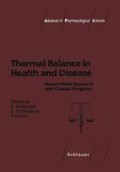Abstract
Much experimental evidence indicating an antagonistic modulatory action of the monoamines 5-hydroxytryptamine (5-HT) and noradrenaline (NA) on hypothalamic thermosensitive and ther-mointegrative neurons, as well as their roles in thermoregulation and thermal adaptation has been reviewed previously (1). Although our knowledge concerning the participating neurochemical transmitter systems has significantly increased, our understanding of their functional role in different species is yet very limited. In different species the thermoregulatory and adaptive strategies may be different and seem to depend on animals’ individual or the inherited experience (2). In the guinea pig, we described the changes in regulatory characteristics, defined as deviations in threshold and gain of thermoregulatory responses to thermal changes during the ontogenic development and adaptation to warm and cold climates (3). In previous experiments we tried to influence these responses by monoamines microinjected or microinfused into the thermointegrative hypothalamic area (cf. refs. 1 and 2 for reviews). Opposite changes could be evoked by microinjections of substances blocking the aminergic receptors in this area or by neurotoxins specifically destroying the synaptic structures (4, 5). From these experiments it was concluded that in the guinea pig the hypothalamic release of NA due to activation of brain stem afferents may increase body temperature, whereas the blockade of hypothalamic adrenergic receptors or a neurochemical lesion induced by microinjected 6-hydroxydopamine (6-OHDA) reduced body temperature.
Access this chapter
Tax calculation will be finalised at checkout
Purchases are for personal use only
Preview
Unable to display preview. Download preview PDF.
References
Brück, K, Zeisberger, E (1990): Adaptive changes in thermoregulation and their neuropharma-cological basis. In: Thermoregulation: Physiology and Biochemistry. Schönbaum, E, Lomax, P eds. New York: Pergamon Press, 255–307.
Zeisberger, E, Roth, J (1994): Central regulation of adaptive responses to heat and cold. In: APS Handbook of Physiology, Section 4, “Adaptation to the Environment”. Fregly, MJ, Blatteis, CM eds. Bethesda: Oxford University Press, — in press-.
Zeisberger, E, Ewen, K (1983): Ontogenetic, thermoadaptive and pharmacological changes in threshold and slope for thermoregulatory reactions in the guinea-pig (Cavia aperea porcellus). J therm Biol 8, 55–57.
Behr, R, Zeisberger, E, Merker, G (1983): Response of the guinea-pig (Cavia aperea porcellus) to external cooling after aminergic denervation of the anterior hypothalamus. J therm Biol 8, 125–128.
Zeisberger, E, Behr, R, Ewen, K, Merker, G (1983): Threshold changes for heat production and dissipation after intrahypothalamic administration of 6-hydroxydopamine. In: Environment, Drugs and Thermoregulation. Lomax, P, Schönbaum, E eds. Basel: Karger, 58–61.
Szelényi, Z, Hinckel, P (1987): Changes in cold- and heat-defence following electrolytic lesions of raphe nuclei in the guinea pig. Pflügers Arch 409, 175–181.
Cunningham, JT, Nissen, R, Renaud LP (1992): Catecholamine depletion of the diagonal band reduces baroreflex inhibition of supraoptic neurons. Am J Physiol 263, R363–R367.
Richardson Morton, KD, Van de Kar, LD, Brownfield, MS, Lorens, SA, Napier, TC, Urban, JH (1990): Stress-induced renin and corticosterone secretion is mediated by catecholaminergic nerve terminals in the hypothalamic paraventricular nucleus. Neuroendocrinology 51, 320–327.
Unger, M, Merker, G, Roth, J, Zeisberger, E (1991): Influence of noradrenergic input into the hypothalamic paraventricular nucleus on fever in the guinea-pig. Pflügers Arch 419, 394–400.
Author information
Authors and Affiliations
Editor information
Editors and Affiliations
Rights and permissions
Copyright information
© 1994 Birkhäuser Verlag Basel
About this chapter
Cite this chapter
Jöckel, J., Zeisberger, E. (1994). Thermoregulatory Changes After Neurochemical Lesions of Catecholaminergic and Serotonergic Neurons in the Lower Brain Stem of the Guinea Pig. In: Zeisberger, E., Schönbaum, E., Lomax, P. (eds) Thermal Balance in Health and Disease. APS Advances in Pharmacological Sciences. Birkhäuser Basel. https://doi.org/10.1007/978-3-0348-7429-8_10
Download citation
DOI: https://doi.org/10.1007/978-3-0348-7429-8_10
Publisher Name: Birkhäuser Basel
Print ISBN: 978-3-0348-7431-1
Online ISBN: 978-3-0348-7429-8
eBook Packages: Springer Book Archive

